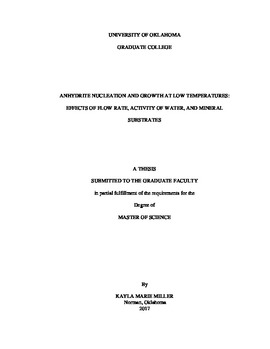| dc.description.abstract | Understanding calcium sulfate mineral formation is crucial to understanding depositional environments and diagenetic conditions on and near the martian surface where calcium sulfates with varying hydration states have been well documented (e.g. Nachon et al., 2014; Vaniman et al., 2014). Calcium sulfate minerals – anhydrite (CaSO4), bassanite (CaSO4· 0.5H2O), and gypsum (CaSO4· 2H2O) – are of particular interest because they serve as good indicators of past aqueous environments on Mars.
Traditionally, gypsum was traditionally thought to form at low temperature, independent of salinity due to kinetic effects, while anhydrite is traditionally understood to form at higher temperatures (>50℃), even though anhydrite is more thermodynamically stable at low temperatures in high salinity, low water activity brines. Closed-system batch experiments conducted by various workers (e.g. Posnjak, 1940; Freyer and Voigt, 2003; Ossario et al., 2014) over the last century have confirmed these assumptions. However, recent flow-through experiments conducted by Dixon et al. (2015) demonstrated low temperature anhydrite formation in high salinity brines in flowing hydrodynamic systems over a three-week period while gypsum formed in closed system batch reactor experiments under identical conditions. They hypothesized that anhydrite may form at low temperatures in flow-through experiments due to the constant source of high salinity, low-water activity brine, while gypsum initially nucleates in the batch reactors, increasing the activity of water as calcium and sulfate ions are consumed. Other workers have suggested that anhydrite, bassanite, and gypsum form via complex nucleation, aggregation, and growth processes (e.g. Van Driessche et al., 2012; Stawski et al., 2016). These pre-cursor nucleation and aggregation phases may be affected by hydrologic flow rates (Dixon et al., 2015), as well as different mineral substrates present in the system (Bystriansky et al., 2016). In this study, we aim to further investigate the role of hydrologic conditions on anhydrite formation at low temperature in flowing brine by testing Dixon et al.’s hypothesis. We also test the effects of varying mineral substrates on calcium sulfate formation by conducting similar experiments reacting calcite (CaCO3) + MgSO4 and MgCl2 brines. We analyzed the reaction products with powder X-ray diffraction, Raman spectroscopy, visible/near infrared spectroscopy, transmission electron microscopy, and scanning electron microscopy.
Our jarosite + brine experimental results confirmed that different calcium sulfate minerals form in flow-through experiments compared to batch experiments, despite identical solution chemistries, reaction time, and temperature conditions. Over a range of CaCl2 concentrations and water activities, anhydrite is only observed in flow-through experiments, while gypsum is observed in both batch and flow-through experiments. Akaganeite is also formed in abundance in all flow-through and batch experiments. Preliminary TEM data show calcium enrichment associated with nanoscale minerals on the edges of jarosite in flow-through experiments. Gypsum was the only calcium sulfate phase identified in batch reactor experiments, where it formed relatively large (>1µm) lath-shaped gypsum crystals in the batch experiments that were not observed in flow-through experiments. These differing mineral assemblages and textures observed in flow-through compared with batch experiments confirm that hydrologic conditions are primary variables affecting calcium sulfate mineralization. No anhydrite was formed in flow-through experiments reacting calcite + sulfate-rich brine, further suggesting anhydrite formation in jarosite + brine flow-through experiments is controlled by mineral substrate or by the presence of other ions in solution in addition to hydrodynamic conditions.
Previous studies have interpreted anhydrite veins on Mars as forming at depth from pre-existing gypsum indicating significant burial had occurred prior to diagenesis (Vaniman et al., 2014; Bristow et al., 2015). However, our experimental results demonstrate that anhydrite can also form at low temperature from jarosite alteration in CaCl2 brines without a pre-existing gypsum phase if there is groundwater flow. Akaganeite is also observed deposits on Mars. Ultimately, our findings can provide much needed data for interpreting the timing and evolution of depositional environments and diagenetic conditions for the sedimentary rocks at Gale Crater and other locations where calcium sulfate minerals have been observed (e.g. Grotzinger et al., 2015; Stack et al., 2016). | en_US |
